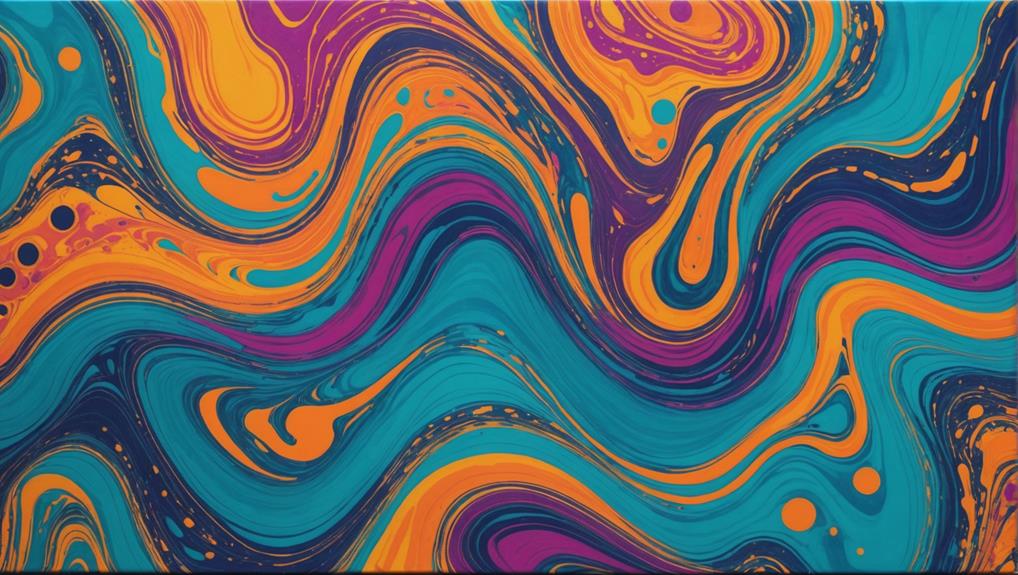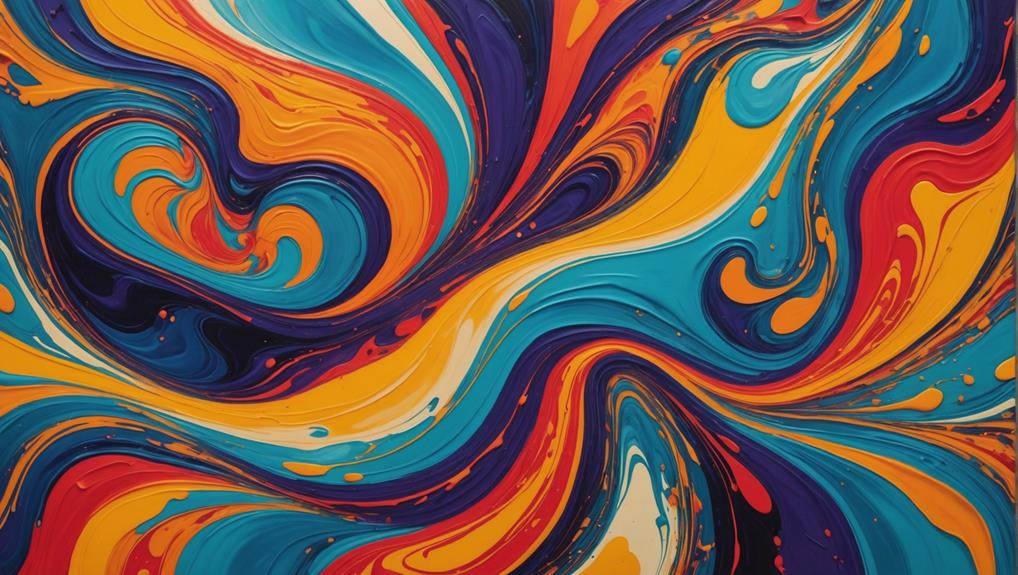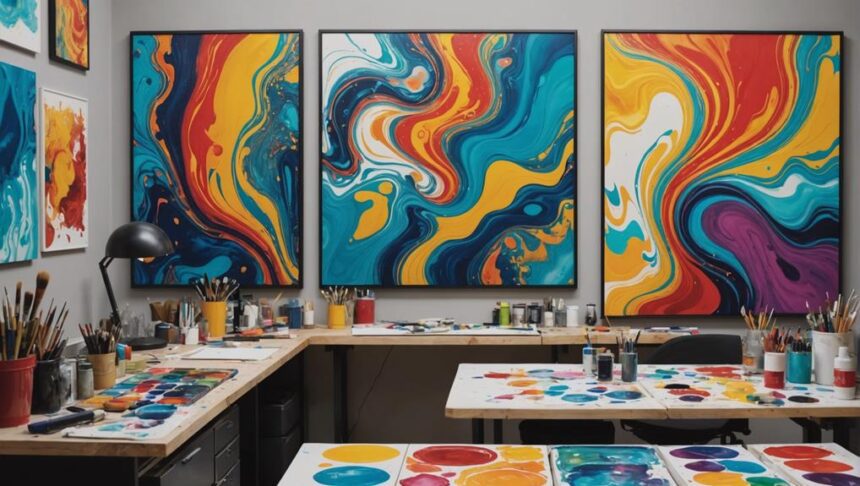To develop your unique style in fluid art, start by playing around with different techniques like dirty pour, flip cup, and swipe; each one creates stunning effects! Mix and match paint brands and pouring mediums to see how they affect your work, and don’t shy away from student-grade paints – they can surprise you. Keep a journal to track your process, noting which combinations wow you. Also, share your creations online and engage with fellow artists to get feedback and new ideas. Remember, it’s all about experimentation, reflection, and connecting with others – your signature style will soon start to shine through!
Key Takeaways
- Experiment with various pouring techniques like dirty pour, flip cup, and swipe to discover unique patterns and effects.
- Test different paint brands and pour mediums to understand their impact on flow, texture, and color vibrancy.
- Document your process and reflect on what works well to refine and evolve your techniques.
- Engage with the fluid art community for feedback, inspiration, and collaborative opportunities.
Explore Various Techniques
Delving into various acrylic pouring techniques, such as the dirty pour, flip cup, and swipe method, allows artists to unearth distinctive visual effects and develop styles that align with their personal aesthetic. These methods offer exciting ways to explore color mixing and layering techniques, leading to stunning results that are both dynamic and unpredictable.
The dirty pour involves mixing multiple paint colors in a single cup before pouring them onto the canvas, creating beautiful, swirling patterns.
The flip cup technique, on the other hand, adds a twist by flipping a cup full of mixed paints onto the canvas, resulting in a bold and spontaneous composition.
The swipe method uses a tool, like a palette knife or paper towel, to drag paint across the canvas, blending colors in a smooth, sweeping motion.
Experimenting with these techniques not only helps artists understand the behavior of different colors and how they interact but also reveals the importance of layering techniques in achieving depth and texture.
Experiment With Paint Brands
Understanding various acrylic pouring techniques is just the beginning; experimenting with different paint brands is equally important for achieving distinctive fluid art results. Each paint brand has its own unique qualities that can markedly influence your artwork’s flow, pigmentation, and overall visual effects. For instance, Liquitex and Golden are often praised for their consistency and high quality, making them reliable choices for many artists.
However, not all paints are created equal. Brand comparisons reveal that paint viscosity can vary notably from one brand to another. This means that how a paint flows and interacts with other materials can change, affecting your final piece. For example, some brands might be better suited for specific techniques like dirty pours or swipe methods, while others might shine in different contexts.
Incorporating a mix of student-grade and artist-grade paints can also be a game-changer. It allows you to explore a diverse palette without breaking the bank. User reviews and personal trials underscore the importance of this experimentation. By testing different brands, you can discover the perfect combination that brings your unique fluid art style to life.
Choose Your Pour Mediums
Selecting the appropriate pour medium is essential as it directly influences the flow, consistency, and final appearance of your fluid art. Pour medium selection can make or break your piece, so it’s a big deal! Popular options like Floetrol, Liquitex Pouring Medium, and even homemade recipes each bring something unique to the table. These medium properties affect everything from shine to texture, and let’s not forget the magical cell formation that many artists crave.
Experimenting with various mediums is like going on a fun adventure. You might discover that one medium makes your colors pop while another creates mesmerizing cell patterns. A common ratio of paint to medium is usually between 1:1 to 1:3, but don’t be afraid to play around with these numbers to get the perfect consistency. It’s like cooking; sometimes you need a pinch more salt or a dash of pepper to get it just right.
Before diving into a big project, it’s smart to test different mediums on small swatches. This way, you can find the perfect combination that aligns with your unique style. Remember, the right pour medium can turn a good piece into a masterpiece!
Document Your Process
Documenting your process in fluid art is an invaluable practice that allows you to track progress, refine techniques, and develop a distinctive artistic style. Start by taking photos or videos at each stage of your pouring technique. This visual record helps you see what works best and what doesn’t, making it easier to nail down your unique approach.
Keeping an art journal is another fantastic way to document your process. Jot down the paint brands, pouring mediums, and techniques you use. This information becomes a goldmine when planning future projects. Plus, it’s super fun to look back and see how far you’ve come!
Experimenting with different color combinations and pour techniques? Record the outcomes. This helps you understand how certain choices influence the final piece, aiding in your artistic growth.
Sharing your documented process with a community of fluid artists can also be incredibly rewarding. Feedback and inspiration from others can provide new perspectives and ideas.
Revisiting your documented works regularly allows you to analyze your growth and shifts in artistic approach. This practice enhances your understanding of evolving preferences and techniques, ensuring continuous improvement in your fluid art journey.
Reflect on Your Creations
Reflecting on your past creations offers invaluable insights into the recurring themes, color palettes, and techniques that define your unique style in fluid art. This artistic reflection is more than just looking back; it’s about understanding what elements make your work distinct and how they contribute to your personal growth as an artist.
Keeping a visual journal of your completed artworks can be incredibly helpful. By documenting each piece, you can track your progress and identify patterns in your work. Maybe you’ll notice a particular color scheme you’re drawn to, or a technique that consistently produces striking results. These insights can guide your future projects, helping you refine and develop your unique style.
Analyzing your successful pieces is another key step. Take the time to dissect what worked well and why. Was it the way you layered the colors, or perhaps the mediums you used? Understanding these elements can encourage you to explore them further, pushing the boundaries of your creativity.
Regularly revisiting and experimenting with your previous works can foster significant personal growth. By challenging yourself to build on past successes and learn from earlier attempts, you’ll continuously evolve, enhancing the originality and impact of your future fluid art creations.
Engage With the Community
Engaging with the fluid art community is vital for artists seeking to expand their techniques, receive valuable feedback, and find inspiration from diverse styles and methods. By participating in online forums and social media groups dedicated to fluid art, you can share your work, exchange ideas, and get inspired by others. These platforms often host community challenges, where artists create pieces based on a common theme or technique. Participating in these challenges not only hones your skills but also exposes you to different perspectives and styles.
Attending local art workshops or virtual meetups can help you build connections with fellow artists. These events offer valuable opportunities to exchange ideas and receive encouragement, which can be important in developing your unique style. Furthermore, sharing your work on platforms like Instagram or TikTok invites constructive criticism and support from a wider audience. This feedback can guide your artistic evolution and help you refine your techniques.
Additionally, actively engaging with others’ artwork by commenting and liking can cultivate relationships that lead to collaborations and shared learning experiences. Being part of group exhibitions can further enhance your exposure and provide a platform to showcase your style to a broader audience.
Combine Different Styles

Combining different styles in fluid art opens up endless possibilities for creativity and innovation.
By blending various techniques like the dirty pour and swipe method, experimenting with diverse color palettes, and fusing different textures and mediums, you can create truly unique and enchanting pieces.
This approach not only enhances the visual impact of your artwork but also helps you discover and develop your own distinct artistic voice.
Technique Blending for Innovation
By integrating various fluid art techniques, such as the flip cup method with the swipe technique, artists can achieve distinctive visual effects and textures that set their work apart. This technique fusion opens up a world of innovative approaches, allowing artists to push the boundaries of what fluid art can be. For example, using a flip cup to create a vibrant base layer and then employing the swipe technique can generate mesmerizing patterns and intricate details that wouldn’t be possible with just one method alone.
Experimenting with different pouring mediums, like combining Floetrol and Liquitex, can also greatly alter the paint’s flow and consistency. Such blending can lead to unexpected and exciting results, adding a new dimension to your artwork. Additionally, incorporating elements from other art styles, such as marbling or traditional painting techniques, can enhance the depth and complexity of your pieces.
Keeping an art journal to document these experiments and their outcomes is invaluable. It helps in refining your techniques and discovering your signature style over time. Engaging with the fluid art community through workshops or online forums can further inspire and provide feedback, fostering your unique artistic voice.
Color Palettes Experimentation
Exploring diverse color palettes, including complementary, analogous, and unexpected combinations like metallics or neons, can profoundly influence the distinctiveness of your fluid art. By experimenting with these varied palettes, you can create striking contrasts or harmonious blends, enhancing the uniqueness of your work.
Color psychology plays an essential role in this process, as different hues can evoke specific emotions and reactions. Understanding these principles enables you to infuse deeper meaning into your art.
Incorporating unexpected colors, such as metallics or neons, introduces an element of surprise, adding depth and interest to your compositions. These bold choices can set your work apart, making it instantly recognizable.
Palette harmony is vital in achieving a coherent and pleasing visual effect. Combining colors with varying saturation and brightness can result in more dynamic and engaging pieces that reflect your personal aesthetic.
Documenting your color palette experiments in an art journal is a valuable practice. This helps identify trends and preferences, guiding you toward a signature color scheme over time.
Texture and Medium Fusion
Building on the foundation of color experimentation, integrating varied textures and mediums can further enhance the distinctiveness of your fluid art creations. By experimenting with different materials and techniques, you can add depth and dimension to your pieces, making them truly unique.
One way to achieve this is through texture layering. This involves using different pour mediums, like Floetrol or Liquitex, to create varied textures and finishes. These mediums, when combined in different ratios, can produce unexpected results, adding a unique touch to your artwork.
Another effective method is incorporating medium contrast. By blending materials like sand, glitter, or metallic paints, you can create striking contrasts that enhance the visual appeal of your art. This fusion of different styles can give your work a distinctive edge.
To keep things interesting, consider trying techniques like the swipe method alongside traditional pouring. This can yield unique surface textures, seamlessly blending different artistic approaches.
Here are some tips to get you started:
- Experiment with different pour mediums for varied textures.
- Add materials like sand, glitter, or metallic paints for depth.
- Use the swipe method to create unique surface textures.
Seek Constructive Feedback
To truly develop your unique style in fluid art, seeking constructive feedback is essential.
By embracing diverse perspectives from peers and analyzing their critiques, you can uncover new insights into your work.
Engaging in dialogues with other artists can inspire fresh ideas and help refine your techniques, ultimately enhancing your artistic journey.
Embrace Diverse Perspectives
Actively seeking constructive feedback from fellow artists and community members is essential for gaining fresh insights and refining your fluid art style.
When you open up to diverse perspectives, it can dramatically influence how you see and develop your art. Engaging with others can introduce you to new artistic influences and cultural inspirations that you might not have considered before.
Consider the following strategies to embrace diverse perspectives:
- Art critique sessions: Participate in both in-person and online critique groups to share your work and get specific, actionable suggestions for improvement.
- Social media platforms: Showcase your artwork on social media and art forums, inviting comments and creating a dialogue that can inspire new ideas and techniques.
- Local and virtual art groups: Join groups focused on fluid art to benefit from the diverse viewpoints and experiences of other artists.
Analyze Artistic Critiques
Receiving constructive feedback is pivotal for the evolution of your fluid art style, offering valuable insights that highlight both strengths and areas for improvement. Imagine pouring your heart into a piece, only to receive comments that open your eyes to aspects you hadn’t considered. This is where analyzing artistic critiques comes into play, helping you refine your work and grow as an artist.
Engaging with a community of artists, whether on social media or in art groups, allows you to tap into a wealth of artistic influences and critique approaches. These varied perspectives can illuminate new pathways for your creativity. When asking for feedback, it’s helpful to focus on specific elements of your artwork like color choices, composition, or technique. This targeted feedback is like a magic potion that can enhance the unique flair of your pieces.
Participating in art challenges and sharing your work doesn’t just build your confidence—it also holds you accountable and sparks new ideas. Embrace critiques with an open mind, and you’ll find that even the toughest feedback can lead to a more distinctive and powerful artistic voice in fluid art.
Engage in Dialogues
Engaging in dialogues with fellow artists is instrumental in obtaining valuable insights and constructive feedback that can greatly refine your unique style in fluid art. Connecting with other artists lets you share your work and hear fresh perspectives, sparking new ideas and pushing your creativity further. Plus, it’s a lot of fun!
Actively participating in online art communities is a great way to get started. These platforms are buzzing with artists enthusiastic to share their thoughts and support each other.
Here’s how engaging in dialogues can be beneficial:
- Artist collaborations: Working with other artists can introduce you to new techniques and ideas, helping you integrate different elements into your fluid art.
- Theme exploration: Discussing themes with your peers can inspire you to experiment with different subjects, adding depth and variety to your work.
- Diverse perspectives: Feedback from various sources, like social media or local workshops, broadens your understanding of what works well in your art.
Cultivate a Signature Approach

Exploring different pouring techniques and materials is essential in cultivating a signature approach to fluid art. By experimenting, you can harness visual inspiration and draw from various artistic influences to shape your unique style. Techniques like the dirty pour or swipe method offer distinct results, allowing you to discover what aligns with your artistic vision.
Additionally, delving into different paint brands and pour mediums can transform the texture and outcome of your work. Each product has unique properties, and finding the right combination can enhance your art to new heights. Regularly reviewing your past creations is also vital; this reflection helps identify recurring patterns, colors, and styles that resonate with you, further informing your signature approach.
Engaging with the fluid art community can be incredibly beneficial, too. Sharing your work and receiving feedback fosters collaboration, sparking new ideas and refining your distinctive style.
Frequently Asked Questions
How Do You Develop a Unique Artistic Style?
Developing a unique artistic style involves exploring various techniques, experimenting with materials, and engaging with the art community. Incorporating artistic influences and emphasizing personal expression are essential to discovering and refining one’s distinctive creative identity.
What Is a Fluid Art Style?
A fluid art style is characterized by the artist’s unique approach to fluid art techniques and color blending, creating distinctive visual aesthetics through pouring methods, paint mediums, and personal experimentation, resulting in individualized compositions and effects.
How to Learn Fluid Art?
To learn fluid art, start by mastering various fluid techniques like dirty pour and swipe method. Experiment with color blending using different acrylic paints and mediums. Engage with online communities and take extensive courses for structured learning.
How to Make Fluid Acrylics?
To make fluid acrylics for acrylic pouring, mix high-quality acrylic paint with a pour medium in a 1:2 ratio. Experiment with color mixing and ratios to achieve desired consistency. Optionally, add silicone oil for unique effects.
Conclusion
Developing a unique style in fluid art involves a multifaceted approach that includes exploring various techniques, experimenting with different paint brands and pour mediums, and documenting the artistic process.
Engaging with the artistic community, combining different styles, seeking constructive feedback, and cultivating a signature approach further contribute to the emergence of a distinctive artistic voice.
Through these efforts, a personalized and recognizable style in fluid art can be achieved.


Leave a Reply